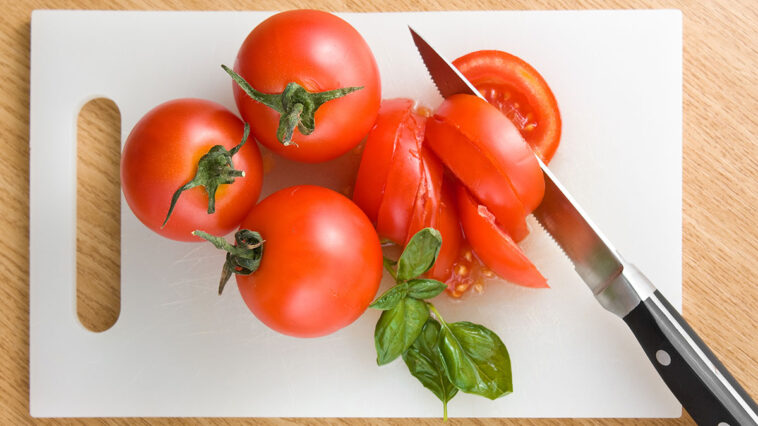Plastic cutting boards are a staple in many kitchens, praised for their durability, affordability, and ease of cleaning. But beneath the convenience lies a less visible and concerning problem: microplastics.
Convenient and common, plastic cutting boards shed tiny particles as you cut and chop, contributing to environmental pollution and perhaps even creating health risks for you and your family. Before you choose a cutting board, check out the implications for the planet and people.
This article contains affiliate links. If you purchase an item through one of these links, we receive a small commission that helps fund our Recycling Directory.
Microplastics: A Cutting-Edge Concern
Microplastics are tiny plastic particles less than 5 millimeters in size, often generated through the wear and tear of larger plastic items. Studies have revealed that plastic cutting boards are a significant source of these particles. A 2022 study published in Environmental Science & Technology found that plastic cutting boards can shed up to 71 million polyethylene and 79 million polypropylene microplastic particles per year into household wastewater.
Every time you slice, chop, or dice, the friction of your knife on the board creates microscopic fragments of plastic that can end up in your food, wastewater, and eventually, the environment. These particles often pass through water treatment plants, eventually reaching rivers, oceans, and soil ecosystems.
Health Implications
Microplastics are increasingly being detected in human tissues and bloodstreams. Research from the Medical University of Vienna in 2018 found microplastics in the blood of 80% of study participants. While the long-term effects remain unclear, concerns about inflammation, hormone disruption, and bioaccumulation are growing.
The Environmental Toll
The plastic particles shed from cutting boards also contribute to environmental pollution. These include:
- Soil Contamination: Microplastics in treated wastewater often accumulate in agricultural soils, impacting plant health and soil biodiversity.
- Marine Pollution: Plastic particles in waterways are ingested by marine life, affecting their reproduction and growth while introducing plastics into the human diet through seafood.
Sustainable Alternatives To Plastic Cutting Boards
Switching to non-plastic cutting boards can help reduce microplastic pollution. Wood cutting boards shed more microparticles than plastic, but they do not pose the same risk if the board is treated with a natural sealant. Your choice can contribute to a healthier meal and a cleaner environment.
Wood
Choose this natural, renewable, and biodegradable option, focusing on hardwood options with a natural finish. Wood also has natural antibacterial properties, making it a hygienic choice. Look for sustainably sourced wood certified by organizations like the Forest Stewardship Council (FSC). Avoid boards coated with synthetic finishes, which can leach chemicals, and consider going finish-free.
Bamboo
Bamboo grows quickly, making it a highly sustainable material. It’s durable, lightweight, and biodegradable.
Be sure to avoid boards laminated with synthetic glues, as these can release toxins over time. Greener Chef makes durable organic bamboo cutting boards with a lifetime replacement guarantee.
Glass
Because they are completely non-porous, glass boards are easy to clean and don’t release particles during use. However, they can dull knives quickly and may break if dropped.
Metal
Whether stainless steel or titanium, metal boards are durable, hygienic, and recyclable. Titanium is the new choice for chefs; it is ideal for heavy-duty tasks without the risk of shedding particles. It can be noisy during use and unsuitable for delicate chopping tasks.
Stone
Stone boards are hard, non-porous, and free of microplastic concerns, making them easy to clean and care for during use. However, the material can be fragile and prone to chipping.
Tips To Reduce Microplastic Exposure from Cutting Boards
If you currently use plastic cutting boards, here are some steps to minimize microplastic pollution:
- Replace Worn Boards: Old and heavily scored boards shed more microplastics. Replace them when deep grooves appear.
- Cut Gently: Use sharp knives and avoid excessive force to reduce friction on the board.
- Choose BPA-Free Plastics: If you stick with plastic, opt for BPA-free boards to prevent the leaching of harmful substances into your food and the environment.
- Rinse Wisely: Rinse chopped foods after you cut them. The way you wash your cutting board can also help reduce the volume of plastics that reach the environment. Use a mesh strainer to catch particles when rinsing cut foods or boards in the sink.
It’s Your Conscious Choice
Although plastic cutting boards offer convenience, the growing evidence about their contribution to microplastic pollution demands thoughtful consideration. By transitioning to sustainable alternatives and adopting mindful kitchen practices, you can reduce your environmental impact and help protect ecosystems and your health.



GIPHY App Key not set. Please check settings